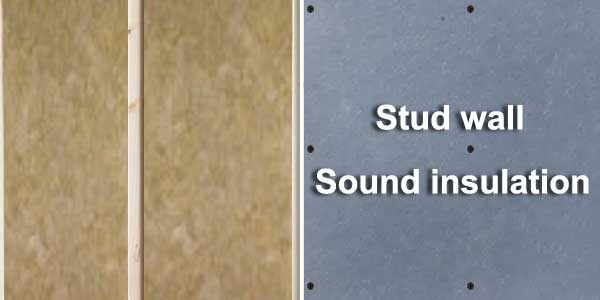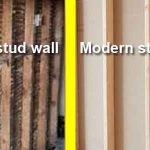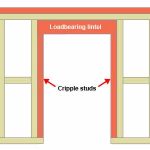Stud walls are by far the most common type of internal wall in residential properties. These are usually made from timber studs that are between 75-100mm thick, plus 12.5mm of plasterboard on each side. This makes them comparable in thickness to a block-built wall.
Building walls in this way is affordable, and also convenient, as studwork is relatively quick and easy to build, with limited mess. This makes it far more convenient than solid internal walls.
However, it does come with some disadvantages, and one of these is the level of soundproofing a stud wall provides. Without additional soundproofing, a stud wall is not very good at blocking noise between rooms.

The good news, is you can take additional measures to ensure that your wall is more soundproof. There are several different steps you can take to reduce sound passing through the stud work. The most popular options include:
- Adding insulation to the studwork
- Use specialist acoustic plasterboards
- Double up standard boards
- A combination of the above
All of the above will reduce sound passing through the wall. You can also combine specialist plasterboard with insulation, to increase the walls efficiency at reducing sound.
What wall insulation is best for sound reduction
The two most common types of insulation used in stud walls, are mineral wool (such as Rockwool), and rigid insulation boards (such as Kingspan). If you want to add soundproofing as well as thermal insulation, both will do a reasonably good job, even with their standard insulation materials.
As a guide, the NHBC recommend using 25mm of mineral wool in stud walls. This is the minimum to meet the required sound proofing levels. Using a similar rigid insulation would have a similar result.
However, an even better option, is using a specially designed sound proofing slab. Rockwool produce a product called sound insulation slab. This is a dense, semi rigid slab, made from stone wool. The product offers a higher level of noise reduction, by trapping sound waves and dampening vibrations. This makes it suitable for walls, floors, and lofts.
Sound insulation slab is available in several thicknesses, including 50,70&100mm, meaning it will fit all standard stud wall thicknesses.
It is also available in widths of 400mm and 600mm. Which again makes it suitable for all standard stud spacing. Generally, timber studwork is spaced at 400mm, although it can be spaced at 600mm on some occasions.
You will often find 600mm spacing in metal stud systems. These are more commonly found in commercial settings and are also quite common in modern apartment buildings.
So, as you can see, there is a size of sound insulation slab for most situations (both width and thickness).
Also, because it is a type of mineral wool, it is still quite flexible. This means it can be manipulated and cut around obstacles such as pipes and wires.
By just adding 50mm of sound insulation slab, in a standard stud wall, you can reduce sound by roughly 41dB.
To learn more about rockwool sound insulation slab and read reviews, click here
Acoustic plasterboards
Another option is to use acoustic plasterboards. These are plasterboard that are specifically designed to reduce sound.
The boards are generally the same thickness as a standard plasterboard. However, they are much denser. As a result they can reduce sound by up to 46dB.
Acoustic boards can be fitted and cut in the same way as a standard plasterboard. The main difference is their weight which is considerably heavier than a standard board.
For example, a standard 2400x1200mm plasterboard from British Gypsum, weighs roughly 24.7kg. Whereas their acoustic board (Soundbloc), in the same dimensions, weighs approximately 33.9kg. This means the boards are just over 37% heavier than a standard plasterboard.
The extra weight can make handling and fitting more of a challenge. However, this shouldn’t cause much of an issue on standard height walls.
Doubling up plasterboard
A budget option, is to double up standards sheets of plasterboard. This can reduce sound through a stud wall by up to 50%. When used in combination with a standard insulation (as recommended by the NHBC) you will receive a reasonably good level of sound reduction.
In order to get the best results from this method, you should ensure that you stagger the joints when installing your second layer of plasterboard. This will reduce noise passing through gaps in the walls face.
To reduce any noise passing through gaps even further, you should fill joints in both layers of plasterboard and finish by skimming the surface with a standard plaster.
Another benefit of adding a second plasterboard, is it will increase the stud walls fire safety rating. Using two standard plaster boards will give you the same level of fire resistance as a fire rated plasterboard. This means, your wall will be fire rated to 60 minutes, as opposed to 30 minutes with a single boarded wall.
Conclusion
As you can see, there are several ways you can add sound proofing to a stud wall. All of the above will make a considerable improvement in reducing sound passing through the wall.
In an ideal scenario, you would use a combination of sound proofing solutions. This will give the wall more mass, using different high-density materials. Different materials, will often be better at dampening noises at different frequencies. This means a combination of different high-density materials, will have a better effect than just one.
As a bare minimum your stud wall should have adequate insulation. This alone will increase the walls ability to absorb sound waves and reduce noise.




